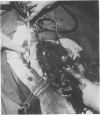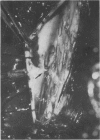Abstract
The authors describe the case history of a patient who was stabbed in the back of his neck with a knife and who later presented with a Brown-Séquard syndrome attributable to cervical spinal cord damage. Myelography and CT revealed a compressive extradural lesion shown at exploratory operation to be a loculus of cerebrospinal fluid (CSF). The loculus had formed as a consequence of leakage of CSF through a dural tear caused by the knife. Evacuation of this loculus resulted in some neurological improvement. The necessity of obtaining a clear history and of performing a thorough clinical examination is explained. The need to admit patients in whom stab wounds of the neck have transgressed subcutaneous fat is reiterated. Early referral to a neurosurgeon is advised for those patients with neurological deficits.
Full text
PDF




Images in this article
Selected References
These references are in PubMed. This may not be the complete list of references from this article.
- Haines S. J., Goodman M. L. Antibiotic prophylaxis of postoperative neurosurgical wound infection. J Neurosurg. 1982 Jan;56(1):103–105. doi: 10.3171/jns.1982.56.1.0103. [DOI] [PubMed] [Google Scholar]
- Herr R. D., Barrett J. An unusual presentation of Brown-Sequard syndrome. Ann Emerg Med. 1987 Nov;16(11):1285–1288. doi: 10.1016/s0196-0644(87)80241-x. [DOI] [PubMed] [Google Scholar]
- Jones F. D., Woosley R. E. Delayed myelopathy secondary to retained intraspinal metallic fragment. Case report. J Neurosurg. 1981 Dec;55(6):979–982. doi: 10.3171/jns.1981.55.6.0979. [DOI] [PubMed] [Google Scholar]
- LIPSCHITZ R., BLOCK J. Stab wounds of the spinal cord. Lancet. 1962 Jul 28;2(7248):169–172. doi: 10.1016/s0140-6736(62)90054-5. [DOI] [PubMed] [Google Scholar]
- Mollman H. D., Haines S. J. Risk factors for postoperative neurosurgical wound infection. A case-control study. J Neurosurg. 1986 Jun;64(6):902–906. doi: 10.3171/jns.1986.64.6.0902. [DOI] [PubMed] [Google Scholar]
- Peacock W. J., Shrosbree R. D., Key A. G. A review of 450 stabwounds of the spinal cord. S Afr Med J. 1977 Jun 25;51(26):961–964. [PubMed] [Google Scholar]
- Swann I. J., MacMillan R., Watson A. A. A study of stab wounds. Arch Emerg Med. 1985 Mar;2(1):31–36. doi: 10.1136/emj.2.1.31. [DOI] [PMC free article] [PubMed] [Google Scholar]
- Tenney J. H., Vlahov D., Salcman M., Ducker T. B. Wide variation in risk of wound infection following clean neurosurgery. Implications for perioperative antibiotic prophylaxis. J Neurosurg. 1985 Feb;62(2):243–247. doi: 10.3171/jns.1985.62.2.0243. [DOI] [PubMed] [Google Scholar]
- de Villiers J. C., Grant A. R. Stab wounds at the craniocervical junction. Neurosurgery. 1985 Dec;17(6):930–936. doi: 10.1227/00006123-198512000-00010. [DOI] [PubMed] [Google Scholar]






